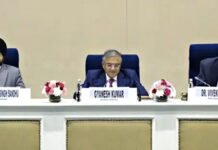
Lucknow: In a high-profile development, the Uttar Pradesh Police encountered the main accused involved in the recent violence in Bahraich, further cementing the state’s ongoing crackdown on criminal activities. This latest encounter has once again brought Chief Minister Yogi Adityanath and the UP Police into the spotlight, continuing a trend that has sparked both praise and criticism over the years.
The incident follows a controversial string of police actions in the state, including the high-profile encounters of Mangesh Yadav, Anuj Pratap Singh, and Zahid just last month. These events have raised the political temperature, with some applauding the government’s tough stance on crime, while others express concerns over the use of lethal force.
A History of Encounters Under Yogi Adityanath’s Rule
Since Yogi Adityanath assumed office as Chief Minister in 2017, police encounters have become a defining feature of his administration’s approach to law and order. The first major encounter under his leadership occurred in Saharanpur, where notorious criminal Mansoor Pehelwan was killed. From that point onward, the UP Police embarked on a relentless campaign, targeting hardened criminals across the state.
According to official data covering the period from March 20, 2017, to September 5, 2024, Uttar Pradesh has witnessed an astounding 12,964 police encounters. In these operations, 207 alleged criminals have been killed, 27,117 criminals arrested, and 1,601 injured. The frequency of these encounters is striking, with an average police-criminal shootout occurring every 13 days.
However, these operations have not come without a cost. Seventeen police officers have lost their lives in the line of duty during Yogi Adityanath’s tenure, and hundreds more have been injured. The state government has incentivized these operations, offering rewards ranging from Rs 75,000 to Rs 5 lakh for capturing or killing wanted criminals.
Political Controversy and Caste Debate
Encounters in Uttar Pradesh have not only raised questions about the use of force but have also ignited political debates around caste dynamics. Caste-based analysis of those killed in encounters reveals a complex picture. Among the 207 slain criminals, 67 were Muslim, 20 Brahmin, 18 Thakur, 16 Yadav, 14 Dalit, 3 from Scheduled Tribes (ST), 2 Sikh, and 8 from other Other Backward Classes (OBC) groups. Additionally, 59 criminals from various other castes and religions have been killed.
This caste-wise breakdown has been a point of contention for opposition parties and activists, who argue that the selective targeting of criminals reflects deep-rooted societal biases. Periodic political debates flare up, focusing on whether caste and religion play a role in how justice is administered in the state.
Bahraich Violence and Public Reaction
The family of the victim in the Bahraich violence had earlier appealed to Chief Minister Yogi Adityanath for strict action, demanding not only encounters but also the demolition of the criminals’ homes. The call for bulldozing properties has become symbolic of Yogi’s administration, often described as “bulldozer politics,” wherein the government demolishes the homes of individuals linked to criminal activities. This policy, while controversial, has earned praise from many citizens who view it as a decisive method of punishing criminals and restoring law and order.

The encounter of the Bahraich violence accused adds another chapter to the Yogi government’s aggressive stance on crime, but it also raises larger questions about governance, justice, and the role of the state in maintaining security. For now, the government’s hardline approach appears to be both a signature feature of its rule and a point of continuing political debate.



















































